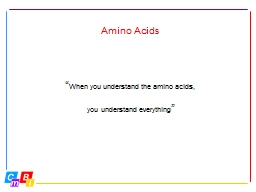

you understand everything Hydrophobicity is the most important characteristic of amino acids It is the hydrophobic effect that drives proteins towards folding Actually it is all done by water Water does not like hydrophobic surfaces When a protein folds exposed hydrophobic side chains g ID: 1034310
Download Presentation The PPT/PDF document "Amino Acids “ When you understand the ..." is the property of its rightful owner. Permission is granted to download and print the materials on this web site for personal, non-commercial use only, and to display it on your personal computer provided you do not modify the materials and that you retain all copyright notices contained in the materials. By downloading content from our website, you accept the terms of this agreement.
1. Amino Acids“When you understand the amino acids, you understand everything”
2. Hydrophobicity is the most important characteristic of amino acids. It is the hydrophobic effect that drives proteins towards folding.Actually, it is all done by water. Water does not like hydrophobic surfaces. When a protein folds, exposed hydrophobic side chains get buried, and release water of its sad duty to sit against the hydrophobic surfaces of these side chains. Water is very happy in bulk water because there it has on average 3.6 H-bonds and about six degrees of freedom.So, whenever we discuss protein structure, folding, and stability, it is all the entropy of water, and that is called the hydrophobic effect.Residue properties determine the alignment scores
3. Residue properties determine the alignment scoresWhen hydrophobic objects come together in water, the number of unhappy waters go down, and that is good for stability.Free waters are happy waters.
4. HYDROPHOBICITY
5. Aliphatic/hydrophobic Ala, Leu, Ile, ValPolar Asn, GlnAlcoholic Ser, Thr, (Tyr)Sulfur-containing Met, CysAromatic Phe, Tyr, Trp, (His)Charged Arg, Lys, Asp, Glu, (His)Special Gly (no R), Pro (cyclic)Helix lovers Ala Met Glu Leu Lys (Gln Phe)Strand lovers Val Ile Thr Trp Tyr PheTurn lovers Pro Ser Asp Asn GlyResidue properties determine the alignment scores
6. Secondary Structure PreferenceAmino acids form chains, the sequence or primary structure.These chains fold in -helices, b-strands, b-turns, and loops (or for short, helix, strand, turn and loop), the secondary structure.These secondary structure elements fold further to make whole proteins, but more about that later.There are relations between the physico-chemical characteristics of the amino acids and their secondary structure preference. I.e., the b- branched residues (Ile, Thr, Val) like to sit in b-strands.
7. β-branched prefers β-strand
8. Secondary Structure Preferences helix strand turnIsoleucine 1.08 1.60 0.47Leucine 1.41 1.30 0.59Phenylalanine 1.13 1.38 0.60Threonine 0.83 1.19 0.96Tryptophan 1.08 1.37 0.96Tyrosine 0.69 1.47 1.14Valine 1.06 1.70 0.50Subset of strand-lovers. These residues either have in common their b-branched nature (Ile, Thr, Val) or their large and hydrophobic character (rest).
9. Secondary Structure PreferenceMost secondary structure elements are located at the surface of the protein:So, most helices have an inward pointing side, and an outward pointing side.
10. Helix
11. Helix
12. Helix
13. Helix
14. Helix
15. Helix
16. Helix So, helices pack because of the hydrogen bonds and because of the hydrophobic packing of side chains along the length of the helix.Ceratin residues do this hydrophobic packing better than others, and those residues are thus good for a helix.
17. Secondary Structure Preferences helix strand turnAlanine 1.42 0.83 0.66 Glutamic Acid 1.39 1.17 0.74 Glutamine 1.11 1.10 0.98Leucine 1.41 1.30 0.59Lysine 1.14 0.74 1.01Methionine 1.45 1.05 0.60Phenylalanine 1.13 1.38 0.60Subset of helix-lovers. If we forget alanine (I don’t understand that things affair with the helix at all), they share the presence of a (hydrophobic) C-b, C-g and C-d (S-d in Met). These hydrophobic atoms pack on top of each other in the helix. That creates a hydrophobic effect.
18. Secondary Structure Preferences
19. Secondary Structure Preferences helix strand turnAspartic Acid 1.01 0.54 1.46Asparagine 0.67 0.89 1.56Glycine 0.57 0.75 1.56Proline 0.57 0.55 1.52Serine 0.77 0.75 1.43Subset of turn-lovers. Glycine is special because it is so flexible, so it can easily make the sharp turns and bends needed in a b-turn. Proline is special because it is so rigid; you could say that it is pre-bend for the b-turn. Aspartic acid, asparagine, and serine have in common that they have short side chains that can form hydrogen bonds with the own backbone. These hydrogen bonds compensate the energy loss caused by bending the chain into a b-turn.
20. Secondary Structure Preferences helix strand turnAlanine 1.42 0.83 0.66 Arginine 0.98 0.93 0.95Aspartic Acid 1.01 0.54 1.46Asparagine 0.67 0.89 1.56Cysteine 0.70 1.19 1.19Glutamic Acid 1.39 1.17 0.74 Glutamine 1.11 1.10 0.98Glycine 0.57 0.75 1.56Histidine 1.00 0.87 0.95Isoleucine 1.08 1.60 0.47Leucine 1.41 1.30 0.59Lysine 1.14 0.74 1.01Methionine 1.45 1.05 0.60Phenylalanine 1.13 1.38 0.60Proline 0.57 0.55 1.52Serine 0.77 0.75 1.43Threonine 0.83 1.19 0.96Tryptophan 1.08 1.37 0.96Tyrosine 0.69 1.47 1.14Valine 1.06 1.70 0.50
21. Chou Fasman parameters Say your dataset is 1000 amino acids and 350 of them are in alpha-helix conformation. This is 35%.There are 50 Alanines in your set and 25 of them are in alpha-helix conformation.This is 50%.The helix preference parameter P for Ala is 50/35=1,43
22. Chou Fasman parameters Take home message:Preference parameter > 1.0 specific residue has a preference for the specific secondary structure.Preference parameter = 1.0 specific residue does not have a preference for, nor dislikes the specific secondary structurePreference parameter < 1.0 specific residue dislikes the specific secondary structure.
23. Simplified Chou Fasman algorithmSelect a window of 7 residuesCalculate average P(alpha) over this window and assign that value to the central residueRepeat calculation for P(beta) and P(turn)Slide the window down one residue and repeat until sequence is completeAnalyze resulting “plot” and assign secondary structure (H,B,T) for each residue.
24. Sequence AlignmentDon’t forget that we still want to gather information about an unknown protein for which we determined the sequence.To gather that information, we will need databases and sequence alignments.To do these sequence alignments, we need to know everything about the amino acids.And that is what we are working on now.